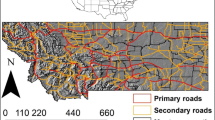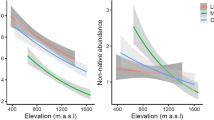Abstract
Native species richness commonly declines with increasing altitude, but patterns of introduced species richness across altitudinal gradients have been less frequently studied. We surveyed introduced roadside weeds along altitudinal transects ranging from 30 to 4,100 m in Hawai’i, with the objectives of (1) testing the hypothesis that a mass effect due to mixing of tropical and temperate species at mid-elevation promotes a hump-shaped pattern of introduced species richness with altitude, and (2) testing the potential roles of anthropogenic activity, energy (temperature) and water-energy dynamics (productivity-diversity hypothesis) in determining introduced weed richness. A total of 178 introduced weeds were recorded. Introduced weed richness does not decline monotonically with altitude. Rather, mixing of tropical and temperate species helps to maintain high mean richness up to 2,000 m, suggesting a mass effect, but without a distinct richness peak. Patchy occurrence of a transformer species, Pennisetum clandestinum, introduced high variance in richness at mid-elevations. General linear models considering estimated actual evapotranspiration (AET, a measure of energy-water dynamics) together with an index of human activity (distance from urban area or length of major roads) accounted for more variance in introduced weed richness than models with energy alone (temperature) and human activity. Native Hawaiian species richness along roadsides was also weakly correlated with AET but negatively associated with human activity. Our observed association between introduced species richness and AET mirrors patterns reported for native species richness around the world, indicating that AET-richness patterns can develop on a short time scale (on the order of 100 years). To test the generality of introduced weed richness patterns, we tried using the Hawai’i island model to predict weed richness on the neighboring island of Maui. Although weed richness on Maui was under-predicted, the same predictors (human activity and AET) were important on Maui. Scaling for differences in regional human population density or economic activity (both higher on Maui) may allow more accurate and transferable quantitative predictions of introduced weed richness patterns.







Similar content being viewed by others
References
Allen AP, Brown JH, Gillooly JF (2002) Global biodiversity, biochemical kinetics, and the energetic-equivalence rule. Science 297:1545–1548
Anonymous (2007) Annual visitor research report. Hawai’i. Department of Business, Economic Development and Tourism, Honolulu
Arévalo JR, Delgado JD, Otto R, Naranjo A, Salas M, Fernández-Palacios JM (2005) Distribution of alien versus native plant species in roadside communities along an altitudinal gradient in Tenerife and Gran Canaria (Canary Islands). Perspect Plant Ecol Evol Syst 7:185–202
Arteaga MA, Delgado JD, Otto R, Fernandez-Palacios JM, Arevalo JR (2009) How do alien plants distribute along roads on oceanic islands? A case study in Tenerife, Canary Islands. Biol Invasions 11:1071–1086
Becker T, Dietz H, Billeter R, Buschmann H, Edwards PJ (2005) Altitudinal distribution of alien plant species in the Swiss Alps. Perspect Plant Ecol Evol Syst 7:173–183
Colautti R, Grigorovich I, MacIsaac H (2006) Propagule pressure: a null model for biological invasions. Biol Invasions 8:1023–1037
Colwell RK, Rahbek C, Gotelli NJ (2004) The mid-domain effect and species richness patterns: what have we learned so far? Am Nat 163:E1–E23
Currie DJ, Kerr JT (2008) Tests of the mid-domain hypothesis: a review of the evidence. Ecol Monogr 78:3–18
Daehler CC (2005) Upper-montane plant invasions in the Hawaiian Islands: patterns and opportunities. Perspect Plant Ecol Evol Syst 7:203–216
Denslow JS, Space JC, Thomas PA (2009) Invasive exotic plants in the tropical Pacific Islands: patterns of diversity. Biotropica 41:162–170
Field R, Hawkins BA, Cornell HV, Currie DJ, Alexandre J, Diniz-Filho F, Guégan J-F, Kaufman DM, Kerr JT, Mittelbach GG, Oberdorff T, O’Brien EM, Turner JRG (2009) Spatial species-richness gradients across scales: a meta-analysis. J Biogeogr 36:132–147
Fischer AG (1960) Latitudinal variations in organic diversity. Evolution 14:64–81
Forster JR (1778) Observations Made during a voyage round the world, on physical geography, natural history, and ethnic philosophy. G. Robinson, London
Gelbard JL, Belnap J (2003) Roads as conduits for exotic plant invasions in a semiarid landscape. Cons Biol 17:420–432
Giambelluca TW, Schroeder TA (1998) Climate. In: Juvik SP, Juvik JO (eds) Atlas of Hawai’i, 3rd edn. University of Hawai’i Press, Honolulu, pp 49–59
Grytnes JA (2003) Species-richness patterns of vascular plants along seven altitudinal transects in Norway. Ecography 26:291–300
Haider S, Alexander J, Dietz H, Trepl L, Edwards PJ, Kueffer C (2010) The role of bioclimatic origin, residence time and habitat context in shaping non-native plant distributions along an altitudinal gradient. Biol Invasions. doi: 10.1007/s10530-010-9815-7
Hargreaves GH, Samani ZA (1982) Estimating potential evapotranspiration. J Irrig Drain E-ASCE 108:225–230
Hawkins BA, Field R, Cornell HV, Currie DJ, Guegan J-F, Kaufman DM, Kerr JT, Mittelbach GG, Oberdorff T, O’Brien EM, Porter EE, Turner JRG (2003) Energy, water, and broad-scale geographic patterns of species richness. Ecology 84:3105–3117
Hobbs RJ, Huenneke LF (1992) Disturbance, diversity, and invasion: Implications for conservation. Cons Biol 6:324–337
Hope D, Gries C, Zhu W, Fagan WF, Redman CL, Grimm NB, Nelson AL, Martin C, Kinzig A (2003) Socioeconomics drive urban plant diversity. Proc Natl Acad Sci USA 100:8788–8792
Kalwij JM, Robertson MP, van Rensburg BJ (2008) Distribution of exotic plants along a steep altitudinal gradient is facilitated by anthropogenic activities. Appl Veg Sci 11:491–498
Kueffer C, Daehler CC, Torres-Santana CW, Lavergne C, Meyer J-Y, Otto R, Silva L (2010) A global comparison of plant invasions on oceanic islands. Perspect Plant Ecol Evol Syst 12:145–161
Lazaridis A (2007) A note regarding the condition number: the case of spurious and latent multicollinearity. Qual Quant 41:123–135
Leu M, Hanser SE, Knick ST (2008) The human footprint in the west: a large-scale analysis of anthropogenic impacts. Ecol Appl 18:1119–1139
Lomolino MV (2001) Elevation gradients of species-density: historical and prospective views. Global Ecol Biogeogr 10:3–13
Mallen-Cooper J, Pickering CM (2008) Linear declines in exotic and native plant species richness along an increasing altitudinal gradient in the Snowy Mountains, Australia. Austral Ecol 33:684–690
Marini L, Gaston KJ, Prosser F, Hulme PE (2009) Contrasting response of native and alien plant species richness to environmental energy and human impact along alpine elevation gradients. Global Ecol Biogeogr 18:652–661
McDougall KL, Morgan JW, Walsh NG, Williams RJ (2005) Plant invasions in treeless vegetation of the Australian Alps. Perspect Plant Ecol Evol Syst 7:159–171
Middleton N, Thomas D (1992) World atlas of desertification. United Nations Environment Programme, Edward Arnold
Mittelbach GG, Steiner CF, Scheiner SM, Gross KL, Reynolds HL, Waide RB, Willig MR, Dodson SI, Gough L (2001) What is the observed relationship between species richness and productivity? Ecology 82:2381–2396
Nogues-Bravo D, Araujo MB, Romdal T, Rahbek C (2008) Scale effects and human impact on the elevational species richness gradients. Nature 453:216–219
O’Brien EM (2006) Biological relativity to water-energy dynamics. J Biogeogr 33:1868–1888
Pauchard A, Alaback PB (2004) Influence of elevation, land use and landscape context on patterns of alien plant invasions along roadsides in protected area of south-central Chile. Cons Biol 18:238–248
Pauchard A, Kueffer C, Dietz H, Daehler CC, Alexander J, Edwards PJ, Arevalo JR, Cavieres LA, Guisan A, Haider S, Jakobs G, McDougall K, Millar CI, Naylor BJ, Parks CG, Rew LJ, Seipel T (2009) Ain’t no mountain high enough: plant invasions reaching new elevations. Front Ecol Environ 7(9):479–486
R Development Core Team (2009) R: a language and environment for statistical computing. R Foundation for Statistical Computing, Vienna, Austria, URL: <http://www.R-project.orgS>
Rahbek C (1995) The elevational gradient of species richness—a uniform pattern? Ecography 18:200–205
Rahbek C (2005) The role of spatial scale and the perception of large-scale species-richness patterns. Ecol Lett 8:224–239
Rangel TFLVB, Felizola Diniz-Filho JA, Bini LM (2006) Towards an integrated computational tool for spatial analysis in macroecology and biogeography. Global Ecol Biogeogr 15:321–327
Richardson DM, Pysek P, Rejmanek M, Barbour MG, Panetta FD, West CJ (2000) Naturalization and invasion of alien plants: concepts and definitions. Diversity Distrib 6:93–107
Rohde K (1992) Latitudinal gradients in species diversity: the search for the primary cause. Oikos 65:514–527
Shmida A, Wilson MV (1985) Biological determinants of species diversity. J Biogeogr 12:1–20
Stevens GC (1992) The elevational gradient in altitudinal range: an extension of Rapoport’s latitudinal rule to altitude. Am Nat 140:893–911
Tarr RS, McMurry FM (1919) World geographies. Macmillan, New York
Tassin J, Riviere JN (2003) Gradient altitudinal de richesse en plantes invasives à l’île de La Réunion (archipel des Mascareignes, océan Indien). Revue d’Ecologie 58:257–270
Wallace AR (1889) Darwinism, an exposition of the theory of natural selection with some applications. Macmillan and Company, London
Wester L, Juvik JO (1983) Roadside plant communities on Mauna Loa Hawaii. J Biogeogr 10:307–316
Whittaker RJ, Heegaard E (2003) What is the observed relationship between species richness and productivity? Ecology 84:3384–3390
Wu I-P (1997) A simple evapotranspiration model for Hawaii: the Hargreaves model. Fact Sheet EN–106. College of Tropical Agriculture and Human Resources, University of Hawaii at Manoa, Honolulu, pp 2
Zobel M, Partel M (2008) What determines the relationship between plant diversity and habitat productivity? Global Ecol Biogeogr 17:679–684
Acknowledgments
We thank David Benitez, who helped identify species in the Volcano National Park and Saddle Road. Survey permits were facilitated by Rhonda Loh (Hawai’i Volcanoes National Park), Steve Bergfeld (Hawai’i district, Division of Forestry and Wildlife [DOFAW]), Stephanie Nagata (Office of Mauna Kea Management), Pattie Johnson (Parker Ranch), and Liz Gordon (Haleakala National Park). Lloyd Loope and an anonymous reviewer provided helpful comments on an earlier version of this paper. This research was supported by National Research Initiative Grant no. 2006-35320-17360 from the USDA National Institute of Food and Agriculture Biology of Weedy and Invasive Species Program.
Author information
Authors and Affiliations
Corresponding author
Rights and permissions
About this article
Cite this article
Jakobs, G., Kueffer, C. & Daehler, C.C. Introduced weed richness across altitudinal gradients in Hawai’i: humps, humans and water-energy dynamics. Biol Invasions 12, 4019–4031 (2010). https://doi.org/10.1007/s10530-010-9816-6
Received:
Accepted:
Published:
Issue Date:
DOI: https://doi.org/10.1007/s10530-010-9816-6




